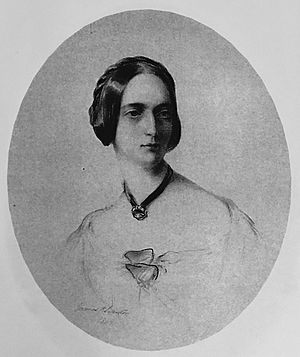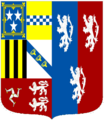Catherine Murray, Countess of Dunmore facts for kids
Quick facts for kids
The Countess of Dunmore
|
|
|---|---|
 |
|
| Born | 31 October 1814 |
| Died | 12 February 1886 (aged 71) Inveresk
|
| Nationality | United Kingdom of Great Britain and Ireland |
| Occupation | philanthropist |
| Known for | supporting the people of Harris and Lewis with work |
Catherine Murray, Countess of Dunmore (born October 31, 1814 – died February 12, 1886) was an important English noblewoman. She is remembered for helping to promote Harris Tweed, a special fabric from Scotland.
Contents
Who Was Catherine Murray?
Catherine Murray was born Lady Catherine Herbert in London. Her father was George Herbert, 11th Earl of Pembroke. Her mother was Countess Catherine Vorontsov, whose father was the Russian Ambassador.
Catherine's Marriage and Family
In 1836, Lady Catherine married Alexander Murray. He became the Earl of Dunmore a few months later. Together, they had four children:
- Lady Susan Catherine Mary (1837–1915)
- Lady Constance Euphemia Woronzow (1838–1922)
- Charles Adolphus, who became the 7th Earl of Dunmore (1841–1907)
- Lady Victoria Alexandrina (1845–1911)
Life as Countess of Dunmore
In 1841, Countess Dunmore became a Lady of the Bedchamber for Queen Victoria. This was an important role helping the Queen. She left this job when her husband passed away four years later.
After her husband's death, she inherited a very large estate. This estate was on the island of Harris in Scotland. It was about 150,000 acres (607 square kilometers).
Improving the Estate Village
Countess Dunmore cared about the people living on her land. She made many improvements to the village on her estate. She built a school for the children. She also created a new village green, which is a common area for everyone to enjoy.
Promoting Harris Tweed
During the Highland Potato Famine in 1846–47, many people in Scotland faced hard times. Countess Dunmore helped her tenants by paying for them to move to new places. She also gave them money to help them start new lives.
She worked with a woman named "Fanny" Beckett to promote Harris Tweed. This was a smart way to help the local people. Harris Tweed is a special fabric made by hand. It uses local wool and traditional methods.
Making Harris Tweed Famous
Countess Dunmore saw that this fabric could be sold to many people. She had her family's special pattern, called a tartan, copied in tweed by local weavers. Soon, suits were being made from this tweed for her estate.
The tweed became very popular. Countess Dunmore wanted to sell it even more widely. The fabric was made by hand, so it sometimes had small differences. She wanted to make it more even, like fabric made by machines.
To do this, she helped the Harris weavers get special training. This training taught them how to make the tweed more consistent. By the late 1840s, Harris Tweed was being sold in London. This helped sales grow a lot.
Later, "Fanny" Beckett moved to London. The company that managed the Harris Tweed product became a limited company in 1896.
Death of Countess Dunmore
Countess Catherine Murray died on February 12, 1886. She was 71 years old. She passed away at Carberry Tower in Inveresk, Scotland. She was buried at Dunmore, Falkirk.
Images for kids




